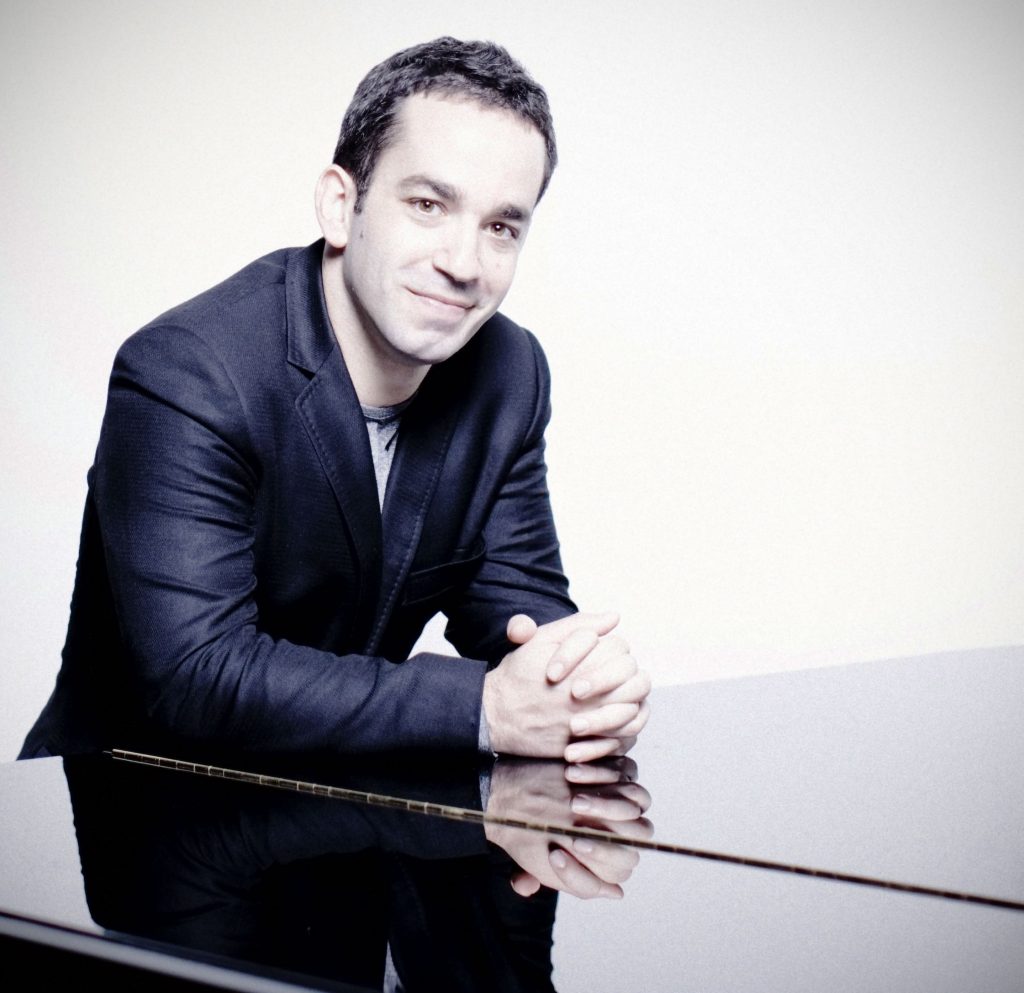Inon Barnatan Soars in Two Piano Concertos to Open San Diego Symphony’s American Music Month
Just when I was thinking that the music of Aaron Copland is old hat and that hearing, say, another rendition of his “Appalachian Spring” would be as enticing as listening to a bored teenager plunk out “Chopsticks,” along comes his rarely heard 1926 Piano Concerto to blow me away. Especially when the piano soloist is Inon Barnatan, whose revelatory performance electrified the San Diego Symphony audience Friday (January 6) in Copley Symphony Hall.
Barnatan’s panache came as no surprise. A few years back he figured prominently in several excellent programs presented by the La Jolla Music Society, and I particularly recall his brilliance in a duo recital with the cellist Alisa Weilerstein in January of 2014. In this two-movement Piano Concerto, Barnatan reveled in young Copland’s flippant revision of the larger-than-life, keyboard-smashing piano concertos of the Russian Romantics, introducing the piano solo with gossamer, Satie-like phrases and then tossing in jazz-inspired rambles that evoked popular ragtime tunes and sensuous stride-piano riffs.No doubt these jazz allusions irked the Boston critics—they hated every note of the work—at the Piano Concerto’s premiere under Serge Koussevitzy, bringing into Boston’s sacred concert hall the popular idioms from smoke-filled clubs that the Brahmin symphony subscribers would never patronize. Barnatan’s acute rhythmic delineations, his clean, sharp attacks, and his propulsive but never rushed tempos did justice to Copland’s delightfully unpredictable invention and completely mesmerized this member of the audience.
In guest conductor Andrew Gourlay, Barnatan had an ideal ally. Making his American debut with the Symphony’s all-American program, the young Brit sagely coaxed excited anticipation from the orchestra even in Copland’s more spare passages. Gourlay emphasized the brass and woodwind solos, keeping the strings at low-profile, an important aspect of young Copland’s anti-Romantic attitudes of the 1920s.
Gourlay had already proven his affinity to Copland’s style in his smart, crisp direction of the program-opening Suite from Billy the Kid, arguably the least frequently programmed of Copland’s popular ballet compositions. Like Béla Bartók’s Concerto for Orchestra, Copland’s masterful orchestration of his ballet gives nearly every first chair player a chance to shine. The San Diego Symphony principals all rose to the occasion with amazing results, especially Principal Trumpet Micah Wilkinson and the fleet mallet-wielding members of the percussion section: I could not imagine a more vibrant, committed performance of this ballet.
Following the Copland immersion of the concert’s first half, Barnatan returned to play yet another piano concerto, Andrew Norman’s “Suspend,” a concerto written for Emmanuel Ax and premiered by the Los Angeles Philharmonic in 2014. Norman outdid Copland’s understatement for the solo piano entrance: for several pages of the score, Barnatan fingered notes above the keys, emitting not a single sound. Then, slowly and mysteriously, single tones slipped in from remote parts of the orchestra and eventually from the keyboard.
Tremulous piano iterations eventually grew into explosive arpeggiations, against which the orchestra created an eerie halo of static chords. Norman, an articulate 36-year-old who was recently named Musical America’s 2017 Composer of the Year, introduced his work from the Copley Symphony Hall stage, inviting the audience to imagine a stellar pianist such as Inon Barnatan entering a vast empty hall, sitting down at a piano to improvise and imagining an orchestra into existence to accompany him.
Although this in not an inherently dramatic scenario, Norman’s “Suspend” clearly engaged the audience on an emotional journey that proved compelling and even transcendent. Barnatan’s miraculous nuance and pellucid articulation played a major role in this achievement, as did Gourlay’s sensitive direction.
Typically, I see the inclusion of George Gershwin’s evergreen “An American in Paris” on a symphony program as an act just short of pandering, but I confess that it completed this concert in an uncannily satisfying manner, especially considering the orchestra’s ebullient account of the work. Perhaps this can be ascribed to Gershwin’s fecund melodic genius so deeply rooted in the American vernacular tradition. As the final benediction to the program that inaugurated this month’s “Our American Music” festival by the San Diego Symphony “An American in Paris” proved the perfect choice.
[themify_box style=”shadow” ]This concert by the San Diego Symphony was performed on Friday, January 6, 2017, in the Jacobs Music Center’s Copley Symphony Hall, 750 B Street, San Diego, CA 92101. The program will be repeated on Sunday, January 8, at 2:00 p.m. in the same venue.[/themify_box]

Ken Herman, a classically trained pianist and organist, has covered music for the San Diego Union, the Los Angeles Times’ San Diego Edition, and for sandiego.com. He has won numerous awards, including first place for Live Performance and Opera Reviews in the 2017, the 2018, and the 2019 Excellence in Journalism Awards competition held by the San Diego Press Club. A Chicago native, he came to San Diego to pursue a graduate degree and stayed.Read more…




This was not an easy program to hear, especially if you subscribe to Masterworks. While the program showcased the musicians’ abilities, it was near-assaultive on the audience. I can appreciate the degree of difficulty in the compositions and the performances – – my college roommate was a piano/conducting major at USC and chose two hours of Schoenberg for his senior recital – – however, they did not rise to the level of Masterworks. American music to the great classics is generally like MOCA to the Getty and Milli Vanilli to The Beatles. Martha Gilmer announced that the programs this season would include music not often heard played by symphony orchestras. I suspect that will be music less popular due to its difficulty on the listener.